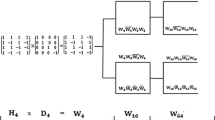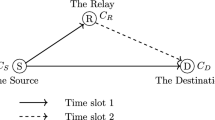Abstract
Walsh–Hadamard transform, a discrete unitary transform is widely used in many applications such as signature codes in the current wireless standards IS-95 CDMA, WCDMA, CDMA2000 and image transform applications. It is simple to implement this transform since they can be generated by a single Kronecker product recursion formula. In this paper, a new set of binary code families similar to Walsh codes are obtained based on the concept of code concatenation and permutation. It is shown that these codes can be generated by reconfiguring the Walsh–Hadamard code generator. Hence it can be utilized in reconfigurable radios such as underlay cognitive radio (UCR). Theoretical results showing the BER performance due to MAI between primary users and secondary users in an UCR is also obtained. Simulation results showing the BER performance of these codes in a direct sequence spread spectrum system and UCR system with quadrature multiplexing operating in the individual decoding mode under AWGN plus flat fading Rayleigh channel conditions is also obtained.
Similar content being viewed by others
References
Devroye, N., Vu, M., & Tarokh, V. (2008). Cognitive radio networks. IEEE Signal Processing Magazine, 12–23.
Budiarjo, I., Nikokar, H., & Ligthart, L. P. (2008). Cognitive radio modulation techniques. IEEE Signal Processing Magazine, 24–34.
Yi, N., Ma, Y. & Tafazolli, R. (2010). Underlay cognitive radio with full or partial channel quality information. International Journal of Navigation and Observation. Article ID 105723. doi:10.1155/2010/105723.
Scutari, G., Palomar, D. P., & Barbarossa, S. (2008). Cognitive MIMO radio. IEEE Signal Processing Magazine, 46–59.
Yue, G. (2008). Antijamming coding techniques. IEEE Signal Processing Magazine, 35–45.
Proakis, J. G. Digital communications (4th ed.). New York: McGraw-Hill International.
Pursley M. B. (1977) Performance evaluation for phase-coded spread-spectrum multiple-access communication-part I: System analysis. IEEE Transactions on Communications COM-25(8): 795–799
Pursley M. B., Sarwate D. V. (1977) Performance evaluation for phase-coded spread-spectrum multiple-access communication-part II: Code sequence analysis. IEEE Transactions on Communications COM-25(8): 800–803
Chen, H.-H. The next generation CDMA technologies. London: Wiley.
Akansu A. N., Poluri R. (2007) Walsh-like nonlinear phase orthogonal codes for direct sequence CDMA communications. IEEE Transactions on Signal Processing 55(7): 3800–3806
Moon, T. K., & Stirling, W. C. Mathematical methods and algorithms for signal processing. Upper Saddle River: Pearson Education.
Moon, T. K., & Stirling, W. C. Error correcting codes: Mathematical methods and algorithms. London: Wiley
Elsner, J. P., Rykaczewski, P., Korner, C., & Jondral, F. K. (2007). Orthogonal complex Hadamard spreading codes for I/Q imbalance mitigation in MC-CDMA systems. VTC, 2661–2665.
Seberry, J., Wysocki, B. J., & Wysocki, T. A. (2003). Williamson–Hadamard spreading sequences for DS-CDMA applications. Wireless Communications and Mobile Computing, 597–607.
Suchitra, G., & Valarmathi, M. L. (2011). BER performance of modified Walsh Hadamard Codes in a DS-CDMA and cognitive underlay system. European Journal of Scientific Research, 563–578.
Parker, M. G., Paterson, K. G., & Tellambura, C. (2004). Golay complementary sequences.
Alaus, L., Palicot, J., Roland, C., Louet, Y., & Noguet, D. (2011). Promising technique of parameterization for reconfigurable radio, the common operators technique: Fundamentals and examples. Journal of Signal Processing System.
Shi, Q., Guan, Y. L., & Law, C. L. (2007). Channel-matched spreading codes for the downlink of MC-CDMA. In ICC 2007 proceedings.
Haykins S. (1998) Digital communications. Wiley, London
Oppermann I., Vucetic B. S. (1997) Complex spreading sequences with a wide range of correlation properties. IEEE Transactions on Communications 45(3): 365–375
Jalil, A. M., Meghdadi, V., & Cances, J.-P. (2009). A new criterion for determining the efficiency of CDMA codes. In 17th European signal processing conference (EUSIPCO) (pp. 1632–1635).
Zhao, Y., Seberry, J., Wysocki, B. J., & Wysocki, T. A. (2006). Complex orthogonal spreading sequences using mutually orthogonal complementary sets. Microwaves, Radar and Wireless Communications, 622–625.
Author information
Authors and Affiliations
Corresponding author
Rights and permissions
About this article
Cite this article
Suchitra, G., Valarmathi, M.L. BER Performance of Walsh–Hadamard Like Kronecker Product Codes in a DS-CDMA and Cognitive Underlay System. Wireless Pers Commun 71, 2023–2043 (2013). https://doi.org/10.1007/s11277-012-0921-y
Published:
Issue Date:
DOI: https://doi.org/10.1007/s11277-012-0921-y




